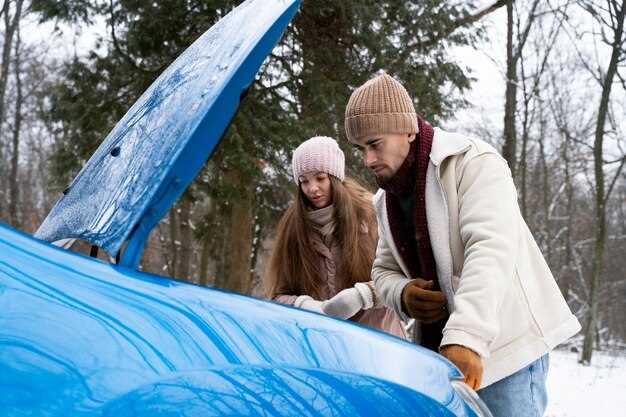
As winter approaches, vintage car enthusiasts must take proactive steps to prepare their prized possessions for the colder months. Proper storage during winter is crucial to prevent damage and ensure that these classic vehicles remain in pristine condition. With their unique materials and engineering, vintage cars require particular attention and care to survive harsh weather conditions.
Understanding the specific needs of vintage cars is essential for any collector. During winter, the potential for rust, engine issues, and battery degradation increases significantly. Therefore, implementing effective winter care practices will not only extend the lifespan of your vehicle but also help maintain its value in the long run. This article discusses the fundamental tips and techniques for safeguarding your vintage car throughout the winter months.
From selecting the right storage environment to performing necessary maintenance tasks, the following guidelines will provide you with the knowledge needed to ensure your vintage automotive treasures withstand the test of time. Emphasizing preparation and vigilance, these strategies will facilitate a smooth transition into spring, allowing you to enjoy your vintage car at its best.”
Preparing Your Vintage Car for Winter Storage

Properly preparing your vintage car for winter storage is essential to ensure its longevity and maintain its value. Start by giving your vehicle a thorough washing and waxing to remove dirt, road salt, and other contaminants that can lead to corrosion. Pay special attention to the undercarriage, as it often accumulates grime and moisture over the winter months.
Next, change the engine oil and replace the oil filter. Old oil contains contaminants that can damage the engine over time. Filling the tank with high-quality fuel and adding a fuel stabilizer will prevent the fuel from breaking down and forming varnish, which can clog the fuel system.
Inspect the battery and clean the terminals to prevent corrosion. If possible, connect the battery to a trickle charger or remove it and store it in a temperature-controlled environment to prolong its life.
Check all fluid levels, including coolant, brake fluid, and transmission fluid. Make sure they are topped off to prevent moisture buildup, which can lead to rust and damage. It’s also wise to inspect and replace any worn hoses or belts to avoid issues when it’s time to take the car out of storage.
Before storage, inflate the tires to the recommended pressure to avoid flat spots. Consider using tire covers or placing the car on jack stands to further protect the tires and suspension system.
Seal any gaps or openings to prevent rodents and pests from getting inside. Using rodent repellent and placing traps around the storage area can also help deter these unwanted visitors.
Finally, cover your vintage car with a high-quality breathable car cover. Avoid plastic covers, as they can trap moisture and lead to mold and mildew. A proper cover will shield the car from dust and scratches while allowing any humidity to escape.
Best Practices for Protecting Your Vehicle from the Elements
When storing vintage cars during winter months, it is essential to safeguard them from harsh environmental factors. Begin by selecting an appropriate storage location that is dry and temperature-controlled, ideally inside a garage or a dedicated storage unit. This helps prevent moisture buildup, which can lead to rust and corrosion.
Ensure your vintage vehicle is thoroughly cleaned before storage. Wash the exterior to remove dirt and grime, and wax it to provide a protective barrier against moisture. Detail the interior to eliminate any food particles or debris that could attract pests during the winter.
Next, consider utilizing a breathable car cover designed specifically for vintage cars. This cover will protect your vehicle from dust and debris while allowing moisture to escape, thus preventing mold and mildew growth inside. Avoid plastic covers, as they can trap moisture, causing more harm than good.
Check all fluid levels before storage, including engine oil, coolant, and fuel. Filling the fuel tank can minimize condensation, while adding a fuel stabilizer can prevent the fuel from breaking down during long periods of inactivity. Additionally, treat the engine oil to ensure it remains in good condition throughout winter.
Inflate the tires to the recommended pressure to prevent flat spots caused by prolonged contact with the ground. If possible, consider elevating the vehicle using jack stands or placing it on a set of tire cradles to further protect the tires.
Lastly, disconnect the battery to prevent drain and corrosion. If feasible, store the battery inside at room temperature, and connect it to a trickle charger to maintain its charge without risk of damage.
Maintenance Steps to Ensure a Smooth Spring Start

As winter storage comes to an end, ensuring your vintage car is ready for the spring season is essential. Proper maintenance during this transition can prevent potential issues and enhance the driving experience. Here are key steps to follow before taking your car out of storage.
First, inspect the battery condition. Cold temperatures can diminish battery life, so check for any signs of corrosion around the terminals and ensure it’s charged. If necessary, recharge or replace the battery to ensure reliable ignition.
Next, examine the fluids in your car. During storage, oil can settle and may not adequately protect your engine. Change the oil and replace the oil filter if it has been sitting for an extended time. Don’t forget to check the coolant, brake fluid, and transmission fluid levels; topping them off is critical for smooth performance.
Tires need attention as well. Inspect them for any signs of flat spots or air loss that may have occurred during winter storage. Inflate to the recommended pressure and check tread depth for safety. Rotating the tires may also be a good idea to distribute wear evenly.
A thorough cleaning is crucial. Wash your vintage car to remove any winter grime and road salt that could cause rust. Pay special attention to the undercarriage and areas where moisture may accumulate, ensuring they are free of debris.
Finally, check all lights and electrical components. Ensure that headlights, brake lights, and turn signals function correctly. This not only guarantees safety but also avoids last-minute surprises when you’re ready to hit the road.
By following these maintenance steps, you will significantly enhance your vintage car’s readiness for spring driving while prolonging its life for years to come.




